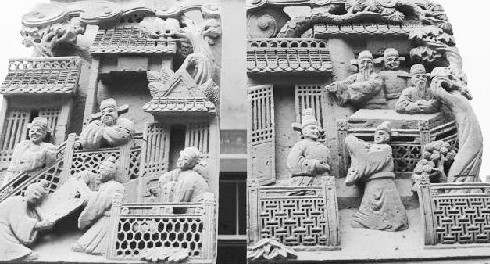Huangshan City, in Southern Anhui province, was the seat of ancient Huizhou, a major cultural and economic hub in history. In the ancient villages scattering this hilly area, time seems to have stood still. Walking down the narrow streets, the Huizhou-style residences on both sides take travelers back hundreds of years. People usually stop to examine the fabulous carvings on the arches. Brick carving is one of main characteristics of Huizhou-style constructions and an integral part of Huizhou architecture.
Using the local gray brick, the carvings were widely used in arches, doorframes, lintels, eaves, roofs, and pillar bases to make the construction more elegant and dignified.
When I met Fang Xinzhong, he was helping his students. Dressed in blue work clothes, he dusted himself off, invited me into his office and told his story from the start.
 |
| Fang Xinzhong's work |
Unexpected Turn of Events
Fang was born in October 1949, when the People’s Republic of China was established, so he was named “Xinzhong,” which means New China. His grandfather Fang Yuyan was a famous educator and had been a member of the Third and Fourth National Committee of the Chinese People’s Political Consultative Conference (CPPCC).
Had the cultural revolution never happened, Fang’s life might have taken a different path: study in Shanghai, work, marriage, family. But “what if?” is never easy to answer, and sometimes the how and why of history can only be put down to “destiny.”
After finishing the first year of middle school, Fang moved to Shexian of Anhui Province with his mother. Fang recalled some fragments of his childhood: his grandfather’s influence, his parents’ jobs as teachers in Shanghai, and their house, just next to that of Madame Soong Ching Ling. Coming from a big city, Fang couldn’t get used to the countryside, and was resigned to the fact. Fortunately, he had his love of painting to brighten his mood. After a day’s farming, Fang would draw pictures on the walls of his own house and even those of neighbors, or make color clay sculptures. “At that time I was always looking for a way out,” Fang said. “Later, I realized that my path had been there all along, right under my nose.”
One day, he came across some exquisite carvings on a house and was immediately drawn to them. Fang tried to carve something on bamboo, the cheapest material he could find.
There were many local carving masters, but Fang had no time or the funds to study. If he had spare time, he would search for well-kept engravings, examining the ancient carvings and replicating them at home. Art is a talent, and in the face of adversity, it is said talent will burst into extraordinary creativity. With persistent efforts, Fang mastered all kinds of carving techniques.
We recommend:
